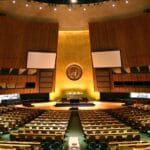Toward a better Nuclear Security Summit
By Pavel Podvig | February 22, 2012
The Nuclear Security Summit taking place in Seoul next month is expected to reinforce the commitment of the international community to confronting the threat of nuclear terrorism. The summit process provides a unique opportunity to ensure that nuclear security receives the high-level attention it deserves from governments around the world. It also entrusts the participants with a special responsibility not to let this opportunity pass by.
The stakes are very high and the challenge is extremely serious: The global stock of fissile material is estimated to be almost 1,440 tons of highly enriched uranium and 500 tons of separated plutonium; together, that’s enough material to produce more than 100,000 weapons or nuclear explosive devices. Large amounts of weapons-usable materials are employed in a broad range of civilian and military applications, which is why they are constant security risks. If some of this material falls into the wrong hands, an act of nuclear terrorism is a real possibility.
And yet, while the global community has long recognized the threat of nuclear terrorism, the international nuclear security regime developed to counter this threat is in need of a serious overhaul. Currently, governments’ obligations are too narrow, accountability is virtually absent, and institutional structures are rather weak. One of the key elements of the international nuclear security regime, the Convention on the Physical Protection of Nuclear Material, covers only a very narrow category of material — civilian nuclear material in international transport — and lacks both accountability and enforcement mechanisms. The Amendment to the Physical Protection Convention, which would extend coverage to domestic transport and storage of nuclear material and would require states to protect their civilian nuclear facilities from sabotage, has not yet entered into force. Another nuclear security agreement, the International Convention for the Suppression of Acts of Nuclear Terrorism, includes an obligation to protect all nuclear material. But nowhere in the agreement is there even a suggested mechanism to ensure compliance with this provision. The convention entered into force in 2007, but a number of key nuclear states — France, Israel, Pakistan, and the United States, among others — have not yet ratified the accord.
The only international institution that has the requisite technical expertise in nuclear security is the International Atomic Energy Agency (IAEA), which develops guidelines and standards for physical protection and provides member states with expert advice and assistance. However, the IAEA can do very little without the direct request of a member state. And even in those cases when it is called on to review a nation’s nuclear security status, the IAEA cannot ensure that its recommendations will be implemented. Also, despite the best efforts of the member states, the IAEA-managed Nuclear Security Fund cannot provide an effective mechanism for the security of nuclear materials.
Most of the weapons-usable nuclear material that exists today has been produced for military purposes. More than 60 percent of plutonium and highly enriched uranium is currently associated with military programs. It is clear that protection of this material should be an absolutely essential part of any nuclear security effort. Countries that have military material in their possession should make a strong commitment to making sure that their military stocks are safe and secure. As an initial step they could declare the amounts of weapons-grade materials in their arsenals and pledge to eliminate the material that is excess to their national security needs. A number of important steps in this direction already have been made: The United States and the United Kingdom have published information on their nuclear material stocks, and the United States and Russia have eliminated large quantities of highly enriched uranium as well as worked together to eliminate large amounts of their military plutonium. The Nuclear Security Summit will provide an opportunity to vigorously support and strengthen these existing nuclear security mechanisms and to ensure that they constitute a norm for all states that have military nuclear materials.
But to be truly effective, the participants should go beyond the existing legal and institutional structures and try to create new initiatives that focus on specific core issues:
• To further promote the transparency and accountability regarding nuclear materials, the Nuclear Security Summit should consider creating a system that would ensure all countries report their civilian nuclear material to the IAEA. This practice is already used today on a smaller scale: Most states that have separated civilian plutonium submit annual declarations of their stocks to the IAEA. Some also report their civilian highly enriched uranium holdings. Non-nuclear weapon states, of course, make all this information available to IAEA as part of their safeguard agreements. These reports need to be made universal in order to properly account for the world’s nuclear materials, an essential step toward ensuring their security.
• Additionally, the reports could have member states detail the status of physical protection at their nuclear facilities. With appropriate care, the reports would not disclose any sensitive information, while still providing states accountability in following the IAEA recommendations and guidelines for basic protection measures. If necessary, these reports could use the procedure developed by the UN Security Council Resolution 1540, which successfully monitored the status of national legislative measures designed to combat proliferation of weapons of mass destruction.
• To make certain that physical protection is adequate to the level of threat, participants of the Nuclear Security Summit should consider establishing a forum that brings together security professionals — intelligence and law enforcement agencies — for consultations on threat assessment. Coordination of efforts in this area would allow the efficient exchange of best practices and would help states develop their national physical protection programs to deal with contemporary threats.
• Finally, the nuclear summit process should carefully study the experience of successful international-cooperation programs that have improved nuclear security in the former Soviet Union and that have worked to remove and secure vulnerable materials worldwide. These are the US-Russian Cooperative Threat Reduction Program, the Group of Eight Global Partnership, and the US Global Threat Reduction Initiative. These programs demonstrate that, with strong political support, states can work together to implement a very ambitious set of goals. To build on the success of these programs, the Nuclear Security Summit should encourage its participants to build partnerships that would bring the resources and commitment necessary to strengthen the nuclear security regime.
One of the most challenging aspects of nuclear security is the multifaceted character of the problem: It requires the coordination of efforts of many states in many areas. The summit provides a particularly important forum that can provide political support to the most ambitious nuclear security programs and work effectively to their ultimate implementation. This makes the Nuclear Security Summit process critical and unique.
Together, we make the world safer.
The Bulletin elevates expert voices above the noise. But as an independent nonprofit organization, our operations depend on the support of readers like you. Help us continue to deliver quality journalism that holds leaders accountable. Your support of our work at any level is important. In return, we promise our coverage will be understandable, influential, vigilant, solution-oriented, and fair-minded. Together we can make a difference.
Topics: Columnists, Nuclear Weapons















